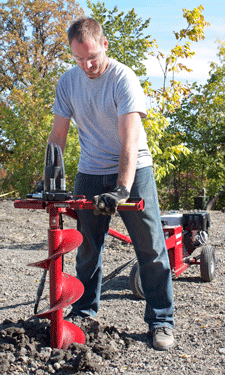 Install a fence. Plant trees. Put in a new park sign. All these different projects share one common link — each requires the proper hole to be drilled in order to adequately complete the task. While all hole-drilling projects may appear to be the same on the surface, it’s often what’s below the surface that really matters. Whether the project calls for several identical holes in grass-covered loam, or a single, large hole in rocky soil, there are drills that allow park and recreation employees to complete projects efficiently and safely.
Install a fence. Plant trees. Put in a new park sign. All these different projects share one common link — each requires the proper hole to be drilled in order to adequately complete the task. While all hole-drilling projects may appear to be the same on the surface, it’s often what’s below the surface that really matters. Whether the project calls for several identical holes in grass-covered loam, or a single, large hole in rocky soil, there are drills that allow park and recreation employees to complete projects efficiently and safely.
There are typically two common styles of engine-powered, one-man earth drills: hydraulic and mechanical. While often similar in appearance, these two styles operate differently and are built with distinct features and options to make them better-suited for certain projects.
Hydraulic drills tackle the most challenging soils, including frozen ground and rocky soil, because of their rugged bodies and powerful torque. Their precise operations at a low speed and high torque allow them to drill accurately in even the most difficult applications. Additionally, hydraulic drills typically have a reverse auger function that safely removes the auger if it becomes lodged under a rock or tree root. And operators can use large-diameter augers with hydraulic drills, making them ideal for single-hole projects such as installing signs and planting trees.
Mechanical drills are compact, lightweight and pack a powerful punch. These transmission-powered units feature high-speed auger rotations to quickly drill clean holes. These drills are best suited for use with small-diameter augers and, due to their high speed, are ideal for projects calling for several narrow holes, such as fitting fence and deck posts and planting decorative plants.
Based on the required hole diameter, the right size auger can easily be paired with the selected drill and most manufacturers will offer several options, from a 1.5-inch-diameter auger that is used for applications like soil nursery work, up to a 16-inch-diameter auger commonly used for repairing foundations.
In addition to efficiency, municipal workers need drills that require minimal maintenance and adjustments. One feature that can help with this is a snap-on auger, which makes the change-out process quick and easy and eliminates the need for extra tools due to its snap button connection. And, snap-on auger extensions allow the operator to achieve various digging depths without requiring additional augers, adding versatility and saving money.
Thanks to the advancements in drill designs, park workers are able to tackle projects with efficient earth drills instead of their shovels and strong backs. Taking the time to learn about the differences in drill styles ensures the success of several aspects of a quality parks and recreation project.
Mike Hale is a Sales Manager with Little Beaver Inc.

